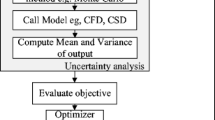Abstract
In this article, the optimization problem of designing transonic airfoil sections is solved using a framework based on a multi-objective optimizer and surrogate models for the objective functions and constraints. The computed Pareto-optimal set includes solutions that provide a trade-off between maximizing the lift-to-drag ratio during cruise and minimizing the trailing edge noise during the aircraft’s approach to landing. The optimization problem was solved using a recently developed multi-objective optimizer, which is based on swarm intelligence. Additional computational intelligence tools, e.g., artificial neural networks, were utilized to create surrogate models of the objective functions and constraints. The results demonstrate the effectiveness and efficiency of the proposed optimization framework when applied to simulation-based engineering design optimization problems.








Similar content being viewed by others
References
Boser BE, Guyon IM, Vapnik VN (1992) A training algorithm for optimal margin classifiers. In: Haussler D (ed) Proceedings of the annual conference on computational learning theory. ACM Press, Pittsburgh, pp 144–152
Chapman B, Jost G, van der Pas R (2008) Using OpenMP: portable shared memory parallel programming. The MIT Press, Cambridge
Cybenko G (1989) Approximation by superpositions of a sigmoidal function. Math Control Signals Syst 2:303–314
Deb K (2001) Multi-objective optimization using evolutionary algorithms. Wiley, Chichester
Deb K, Agrawal S, Pratap A, Meyarivan T (2000) A fast elitist non-dominated sorting genetic algorithm for multi-objective optimization: NSGA-II. In: Schoenauer M, Deb K, Rudolph G, Yao X, Lutton E, Merelo J, Schwefel HP (eds) Parallel problem solving from nature - PPSN VI, Springer, LNCS, vol 1917, pp 849–858
Drela M, Giles MB (1987) Viscous-inviscid analysis of transonic and low Reynolds number airfoils. AIAA J 25(10):1347–1355
Eberhart RC, Shi Y (2007) Computational intelligence - concepts to implementations. Morgan Kaufmann Publishers, Burlington
Fang KT (1980) The uniform design: application of number-theoretic methods in experimental design. Acta Math Appl Sin 3:363–372
Fang KT, Lin DKJ, Winker P, Zhang Y (2000) Uniform design: theory and applications. Technometrics 42:237–248
Giannakoglou KC (2002) Design of optimal aerodynamic shapes using stochastic optimization methods and computational intelligence. Prog Aerosp Sci 38(1):43–76
Goldstein ME (1976) Aeroacoustics. McGraw-Hill, London
Hall M, Frank E, Holmes G, Pfahringer B, Reutemann P, Witten IH (2009) The WEKA data mining software: an update. SIGKDD Explor Newsl 11(1):10–18
Harris CD (1990) NASA supercritical airfoils: a matrix of family-related airfoils. NASA Technical Paper 2969
Hosder S, Schetz JA, Mason WH, Grossman B, Haftka RT (2010) Computational-fluid-dynamics-based clean-wing aerodynamic noise model for design. J Aircr 47(3):754–762
Howe MS (1978) A review of the theory of trailing edge noise. J Sound Vib 61(3):437–465
International Civil Aviation Organization (2008) International standards and recommended practices, environmental protection, annex 16 to the convention on international civil aviation. Vol. 1: aircraft noise, 5th edn. Montreal, Canada
Jameson A (1974) Iterative solution of transonic flows over airfoils and wings, including flows at Mach 1. Commun Pure Appl Math 27:283–309
Jameson A (1988) Aerodynamic design via control theory. J Sci Comput 3(3):233–260
Jin Y (2005) A comprehensive survey of fitness approximation in evolutionary computation. Soft Comput 9(1):3–12
Jones BR, Crossley WA, Lyrintzis AS (1998) Aerodynamic and aeroacoustic optimization of airfoils via a parallel genetic algorithm. AIAA Paper 98-4811. In: Proceedings of the 7th AIAA/USAF/NASA/ISSMO Symposium on Multidisciplinary Analysis and Optimization, St. Louis, MO
Jouhaud JC, Sagaut P, Montagnac M, Laurenceau J (2007) A surrogate-model based multidisciplinary shape optimization method with application to a 2D subsonic airfoil. Comput Fluid 36(3):520–529
Kotinis M (2011) Implementing co-evolution and parallelization in a multi-objective particle swarm optimizer. Eng Optim 43(6):635–656
Leifsson LT, Mason WH, Schetz JA, Haftka RT, Grossman B (2006) Multidisciplinary design optimization of low-airframe-noise transport aircraft. AIAA Paper 2006-230
Lilley GM (2001) The prediction of airframe noise and comparison with experiment. J Sound Vib 239(4):849–859
Menter FR (1994) Two-equation eddy-viscosity turbulence models for engineering applications. AIAA J 32(8):1598–1605
Rumelhart DE, Hinton GE, Williams RJ (1986) Learning representations by back-propagating errors. Nat 323:533–536
Shevade SK, Keerthi SS, Bhattacharyya C, Murthy KRK (2000) Improvements to the SMO algorithm for SVM regression. IEEE Trans Neural Netw 11(5):1188–1193
Simpson TW, Lin DKJ, Chen W (2001) Sampling strategies for computer experiments: Design and analysis. Int J Reliab Appl 2(3):209–240
Smola AJ, Schölkopf B (2004) A tutorial on support vector regression. Stat Comput 14(3):199–222
Sobieszczanski-Sobieski J, Haftka RT (1997) Multidisciplinary aerospace design optimization: survey of recent developments. Struct Multidisc Optim 14(1):1–23
Üstün B, Melssen WJ, Buydens LMC (2006) Facilitating the application of support vector regression by using a universal Pearson VII function based kernel. Chemometr Intell Lab 81(1):29–40
Wang XD, Hirsch C, Kang Sh, Lacor C (2011) Multi-objective optimization of turbomachinery using improved NSGA-II and approximation model. Comput Methods Appl Mech Eng 200:883–895
Whitcomb RT (1974) Review of NASA supercritical airfoils. ICAS Paper No. 74-10
Yang BS, Yeun YS, Ruy WS (2002) Managing approximation models in multi-objective optimization. Struct Multidisc Optim 24(2):141–156
Author information
Authors and Affiliations
Corresponding author
Rights and permissions
About this article
Cite this article
Kotinis, M., Kulkarni, A. Multi-objective shape optimization of transonic airfoil sections using swarm intelligence and surrogate models. Struct Multidisc Optim 45, 747–758 (2012). https://doi.org/10.1007/s00158-011-0719-7
Received:
Revised:
Accepted:
Published:
Issue Date:
DOI: https://doi.org/10.1007/s00158-011-0719-7




